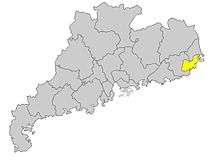Shantou dialect
The Shantou dialect, formerly known as the Swatow dialect, is a Chinese dialect mostly spoken in Shantou in Guangdong, China. It is a dialect of Chaoshan Min language.[2]
| Shantou dialect | |
|---|---|
| Swatow | |
| 汕頭話 Suan¹tao⁵ uê⁷ | |
| Native to | China |
| Region | Mainly in Shantou, southwestern Guangdong province. |
Sino-Tibetan
| |
| Peng'im | |
| Language codes | |
| ISO 639-3 | – |
| Glottolog | shan1244[1] |
| Linguasphere | 79-AAA-jif |
 Shantou dialect | |
Phonology
Shantou dialect has 18 initials, 61 rimes and 8 tones.
Initials
| Stop | Affricate | Fricative | Nasal | Lateral | |||||
|---|---|---|---|---|---|---|---|---|---|
| Voiceless | Voiced | Voiceless | Voiceless | Voiced | Voiced | ||||
| Tenuis | Aspirated | Tenuis | Tenuis | Aspirated | |||||
| Bilabial | p 波 | pʰ 抱 | b 無 | m 毛 | |||||
| Alveolar | t 刀 | tʰ 天 | ts 之 | tsʰ 此 | s 思 | z 入 | n 腦 | l 羅 | |
| Velar | k 哥 | kʰ 戈 | g 鵝 | ŋ 俄 | |||||
| Glottal | ʔ 烏 | h 何 | |||||||
Rimes
| i 衣 | u 污 | |
| a 亞 | ia 呀 | ua 娃 |
| o 窩 | io 腰 | |
| e 啞 | ue 鍋 | |
| ɯ 余 | ||
| ai 哀 | uai 歪 | |
| oi 鞋 | ui 威 | |
| au 歐 | iau 夭 | |
| ou 烏 | iu 憂 | |
| ĩ 丸 | ||
| ã 噯 | ĩã 營 | uã 鞍 |
| ĩõ 羊 | ||
| ẽ 楹 | ||
| ɯ̃ 秧 | ||
| ãĩ 愛 | ||
| õĩ 閑 | ||
| im 音 | ||
| am 庵 | iam 淹 | |
| iŋ 因 | uŋ 溫 | |
| aŋ 按 | iaŋ 央 | uaŋ 汪 |
| oŋ 翁 | ioŋ 雍 | |
| eŋ 英 | ||
| ɤŋ 恩 | ||
| iʔ 裂 | ||
| aʔ 鴨 | iaʔ 益 | uaʔ 呴 |
| oʔ 學 | ioʔ 約 | |
| eʔ 厄 | ||
| oiʔ 狹 | iuʔ | |
| ip̚ 邑 | ||
| ap̚ 盒 | iap̚ 壓 | uap̚ 法 |
| ik̚ 乙 | uk̚ 熨 | |
| ak̚ 惡 | iak̚ 躍 | uak̚ 獲 |
| ok̚ 屋 | iok̚ 育 | |
| ek̚ 液 | ||
| m̩ 唔 |
Tones
| No. | 1 | 2 | 3 | 4 | 5 | 6 | 7 | 8 |
|---|---|---|---|---|---|---|---|---|
| Tones | dark level 陰平 |
dark rising 陰上 |
dark departing 陰去 |
dark entering 陰入 |
light level 陽平 |
light rising 陽上 |
light departing 陽去 |
light entering 陽入 |
| Tone contour | ˧ (33) | ˥˧ (53) | ˨˩˧ (213) | ˨ (2) | ˥ (55) | ˧˥ (35) | ˩ (11) | ˥ (5) |
| Example Hanzi | 詩 | 死 | 四 | 薛 | 時 | 是 | 示 | 蝕 |
Tone sandhi
Shantou dialect has extremely extensive tone sandhi rules: in an utterance, only the last syllable pronounced is not affected by the rules. The two-syllable tonal sandhi rules are shown in the table below:
| Original citation tone | Tone sandhi |
|---|---|
| dark level 33 | 23 |
| light level 55 | 21 |
| dark rising 53 | 35 |
| light rising 35 | 21 |
| dark departing 213 | 55 |
| light departing 11 | 12 |
| dark entering 2 | 5 |
| light entering 5 | 2 |
gollark: <@151391317740486657>
gollark: > can i reverse engineer potatOSYep!> and make my own omnidiskNope!
gollark: Or I guess you could compile your whole thing including the license verification to bytecode.
gollark: <@154361670188138496> I mean, kind of. Thing is, OmniDisks\™ are basically only useful for getting around PotatOS sandboxing. So if they can't do that the disk is useless.This sort of "only useful in an environment you fully control" sandboxing is the only workable sort.
gollark: It also contains valid disk IDs for each UUID and disk IDs are unique to each disk and unspoofable.
References
- Hammarström, Harald; Forkel, Robert; Haspelmath, Martin, eds. (2017). "Shantou". Glottolog 3.0. Jena, Germany: Max Planck Institute for the Science of Human History.
- Shantou Dialect entry in Glossika
- Office of Chorography of Shantou City 汕头市地方志办公室 (1999). Shan tou shi zhi 汕头市志 ["Chorography of Shantou City"]. 72. Beijing: Xinhua chubanshe 新华出版社 ["Xinhua Publishing House"]. ISBN 9787501143870.
Further reading
- Fielde, Adele M. (1883). A pronouncing and defining dictionary of the Swatow dialect, arranged according to syllables and tones. Shanghai: American Presbyterian Mission Press. Retrieved 2015-04-01.
- Fielde, Adele M. (1878). First Lessons in the Swatow Dialect. Swatow: Swatow Printing Office Company. Retrieved 2015-04-01.
- Lechler, Rudolf, Samuel Wells Williams , William Duffus (1883). English-Chinese Vocabulary of the Vernacular or Spoken Language of Swatow. Swatow: English Presbyterian Mission Press. Retrieved 2015-04-01.CS1 maint: multiple names: authors list (link)
- Hsiung-chʻêng, Lin (1886). A handbook of the Swatow vernacular. Singapore: Koh Yew Hean Press. Retrieved 2015-04-01.
This article is issued from Wikipedia. The text is licensed under Creative Commons - Attribution - Sharealike. Additional terms may apply for the media files.
